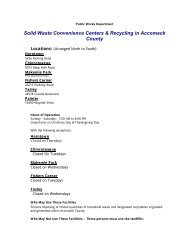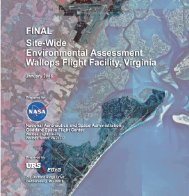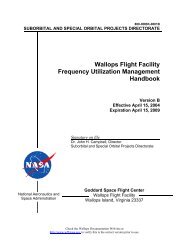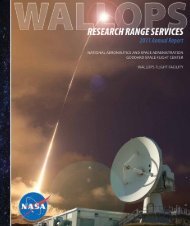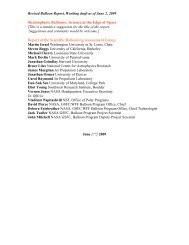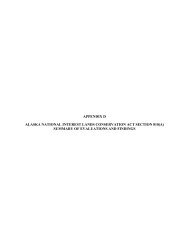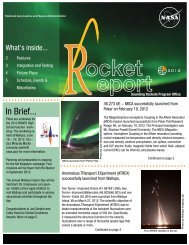Alternative Energy Draft EA - NASA Visitor Center at Wallops Flight ...
Alternative Energy Draft EA - NASA Visitor Center at Wallops Flight ...
Alternative Energy Draft EA - NASA Visitor Center at Wallops Flight ...
Create successful ePaper yourself
Turn your PDF publications into a flip-book with our unique Google optimized e-Paper software.
Executive Summary<br />
kW wind turbines would be installed near the WFF <strong>Visitor</strong> <strong>Center</strong>, and a second one would be<br />
installed near the security guard st<strong>at</strong>ion <strong>at</strong> the Mainland. The loc<strong>at</strong>ions of the remaining three<br />
residential-scale wind turbines are unknown <strong>at</strong> this time, but would be placed within the areas<br />
th<strong>at</strong> <strong>NASA</strong> has identified as potential suitable loc<strong>at</strong>ions <strong>at</strong> WFF. The residential-scale turbines<br />
would not contribute much to the percent of energy gener<strong>at</strong>ed from renewable sources <strong>at</strong> WFF<br />
because of their small power output; their primary purpose would be to provide outreach and<br />
educ<strong>at</strong>ion to WFF employees and the public about wind energy.<br />
New access roads would be constructed to each utility-scale wind turbine. Underground power<br />
collection lines would be built to interconnect each wind turbine to the existing <strong>Wallops</strong> Island<br />
electrical distribution system. These power lines would be installed by directional drilling, a<br />
trenchless method, to avoid affecting wetlands. Previously disturbed areas, including the cleared<br />
area east of the U.S. Navy V-10/V-20 complex, would be used for staging of equipment and<br />
m<strong>at</strong>erials for the utility-scale turbines, and for construction vehicle parking. The construction<br />
period for the two utility-scale wind turbines would be approxim<strong>at</strong>ely 6 months.<br />
The residential-scale wind turbines would be constructed with a setback distance of 30 meters<br />
(100 feet) from existing towers, buildings, and trees. No transformers or interconnection<br />
switchgear would be needed.<br />
<strong>Altern<strong>at</strong>ive</strong> One<br />
Under <strong>Altern<strong>at</strong>ive</strong> One, <strong>NASA</strong> would construct one utility-scale wind turbine on <strong>Wallops</strong> Island<br />
th<strong>at</strong> would be capable of gener<strong>at</strong>ing 5 GWh of electricity per year. The single 2.0 MW wind<br />
turbine would be loc<strong>at</strong>ed west of the U.S. Navy V-10/V-20 complex in the same loc<strong>at</strong>ion as the<br />
southern wind turbine under the Proposed Action. The footprint, work space, and staging areas<br />
would be the same as described under the Proposed Action, but the construction period would be<br />
approxim<strong>at</strong>ely 4 months. <strong>NASA</strong> would also install up to five 2.4 kW wind turbines <strong>at</strong> the Main<br />
Base and Mainland as described under the Proposed Action <strong>Altern<strong>at</strong>ive</strong>.<br />
In addition to the wind turbines, <strong>NASA</strong> would install a system of solar panels <strong>at</strong> <strong>Wallops</strong> Main<br />
Base th<strong>at</strong> would be capable of gener<strong>at</strong>ing up to 5 GWh/year (the equivalent of one utility-scale<br />
wind turbine). Approxim<strong>at</strong>ely 19,000-square-meter (15-square-foot) solar panels, equaling an<br />
area of approxim<strong>at</strong>ely 3 hectares (7.5 acres), would be needed to meet this power gener<strong>at</strong>ing<br />
capability. Panel spacing requirements (to avoid shading and allow maintenance) would increase<br />
the overall required land area dedic<strong>at</strong>ed to solar panels to approxim<strong>at</strong>ely 16 hectares (40 acres).<br />
The power gener<strong>at</strong>ed by the solar panels would be connected via underground transmission lines<br />
to a set of switchgear th<strong>at</strong> would be enclosed in a small 5-meter by 6-meter (16-foot by 20-foot)<br />
pre-fabric<strong>at</strong>ed building. Solar panels would be installed in open, grassy areas of <strong>Wallops</strong> Main<br />
Base. The install<strong>at</strong>ion period for the solar panels would be approxim<strong>at</strong>ely 2 months.<br />
<strong>Altern<strong>at</strong>ive</strong> Two<br />
<strong>NASA</strong> would install up to five 2.4 kW wind turbines <strong>at</strong> the Main Base and Mainland as<br />
described under the Proposed Action <strong>Altern<strong>at</strong>ive</strong>. <strong>Altern<strong>at</strong>ive</strong> Two would also consist of<br />
installing a system of solar panels <strong>at</strong> <strong>Wallops</strong> Main Base th<strong>at</strong> would be capable of gener<strong>at</strong>ing 10<br />
GWh/year of power. To produce this amount of energy, WFF would install approxim<strong>at</strong>ely<br />
38,000-square-meter (15-square-foot) solar panels th<strong>at</strong> would equal an area of approxim<strong>at</strong>ely 6<br />
hectares (15 acres). Panel spacing requirements (to avoid shading and allow maintenance) would<br />
ii




